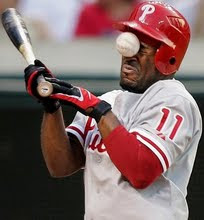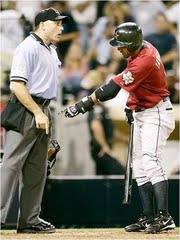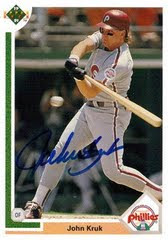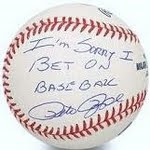Jarrod Washburn (2.97 ERA, 1.08 WHIP) and Kevin Millwood (2.13 ERA, 0.97 WHIP), who probably went undrafted in your leagues this season, have been surprisingly effective through April. Their FIPs are each at least a full run above their ERA, but I still like one of them...can you guess which? I'll analyze each.
JARROD WASHBURN
Washburn is as old as dirt and he's hasn't been good since sod was invented. Since 2002, his ERA has been 4.3 or higher (often much higher) all but once (2005, when it was 3.20). Over this same time period, Jarrod Washburn's single season best FIP was 4.35 (in 2005). With the exception of 2005, his FIP has been +4.5 since 2002. In fact, throughout his entire career, Washburn's FIP has only been below 4.35 ONCE (2002, when it was 3.71).
Despite posting sub-3 BB/9 rates (very good) in all but one season since 2000, Washburn's control has often been burned by posting a career 1.15 HR/9 rate (and this gopher rate didn't improve when he moved to Safe Co. Park) and an anemic 5.37 K/9 rate. As all of these number should indicate, Washburn has problems getting guys out on his own and can't get out of jams. He put the ball in play often (5% above league average) and relies heavily on the defenders behind him to succeed...which is why I like him in 2009.
Despite his home run tendencies in a spacious field, flyballer Jarrod Washburn is backed up by three outfielders (Chavez, Gutierrez, Ichiro) who rank top 10 amongst all players in UZR/150 (86 runs above average, collectively) by a large margin. Even back up outfielders Ronny Cedeno (32 UZR/150), Wladimir Balentien (37.9 UZR/150) and Ken Griffey Jr. (58 UZR/150) have chipped in over 100 collective innings of work to keep the green covered. Surely, such high UZR ratings from a guy like Griffey won't continue, but the rest of the OF a testament to the defensive direction the Mariners have taken their team in 2009. Even though their batting lines are Mendoza like (well, except Ichiro, who has uncharacteristically posted a Mendoza-like batting line thus far this season), the Mariners' outfield is among (if not) the best defensively in baseball and since runs differential is as equally made up of Runs Prevention as Runs Creation, could be a formula for success.
This defense-heavy team yields to me several conclusions:
1) The closer of this team is going to get a lot of Save Opportunities. A lackluster offense is going to make the bulk of the Mariners' wins close games (3 runs or less).
2) Flyballs that aren't home runs are going to be converted into outs. This means that a guy like Washburn, who doesn't walk guys very often (2.77 BB/9 career) and keeps all but 35% of his balls in play off the ground, is going to post some great numbers -- even if he isn't striking guys out -- because he's less likely to have to pitch out of jams and have guys on the basepaths.
Over the course of 200+ IP, I confidently claim that Washburn will end up with a sub-4 ERA (is 3.70 realistic?), double digit wins and a 1.3 WHIP.
KEVIN MILLWOOD
Oh K.W., where shall we begin? It's bad enough you pitch at the Ballpark in Arlington, but the declining K's and fastball velocity since 2004 are downright worrisome. Despite decent peripherals over the past few years, I question what a 4.00 FIP and 1.0 HR/9 rate look like at place like Arlington (actually, it looks like this). It's true that Millwood limits his free passes (2.72 BB/9 career) and keeps the ball out of the air at a pretty good rate (1.34 GB/FB on the Rangers), but Millwood has often been the victim of above average peripherals (2.62 K/BB career) and bad results (he's only thrice posted a sub-4 ERA in his career, never sub-4.5 in Arlington).
Compared to last season, not much in Millwood's approach has changed. His 2.75 K/BB is up slightly from last year's 2.55 rate, but so are his home runs (1.18 per nine this season, compared to 0.96 per nine last year). In terms of how they proportionately impact runs prevention, a strikeout is worth -2 points, walk is worth +3 points and a home run is worth +13 points. Thus, marginal gains in control are completely overshadowed and erased by even more marginal gains in long ball rates. This all indicates one thing: Millwood's current 2.13 is quite deceptive. His FIP is a full 2.12 runs higher, which indicates some rocky times are ahead for Millwood this season.
At best, Millwood may put up solid numbers in spot starts on the road in Oakland and Seattle. You don't want to know what Kevin Millwood's dark side looks like.
Millwood for Nolasco or Cueto may be a trade someone is willing to take. If so, you better offer it soon, while Millwood's value is still at its peak.
skip to main |
skip to sidebar

That pitch accounted for 15% of Jimmy Rollin's OBP for 2006

Is my .320 batting average giving you a boner?

That Darren Erstad was a punter in college??

John Kruk struck out in this AB

Statistically speaking, sacrifice bunts are counter-productive

Best signature ever

Written by none other than Joe Morgan
Buy Tickets!
Gophers Fans, Buy Gophers Tickets including Gopher Basketball Tickets today. Check out Williams Arena Tickets and buy Minnesota Gophers Basketball Tickets today.
The 25 Greatest Movies Of The Past 25 Years
GOI Fantasy Sports Analysis
Contributors
- Sexy Rexy
- The 'Bright' One
- David "MVP" Eckstein
- Cubsfan4evr
Board Bets
Search GOI, Fangraphs, And The Hardball Times For Content
Local Blogs We're Reading
National Blogs We're Reading
Finding Stats
Faceball

That pitch accounted for 15% of Jimmy Rollin's OBP for 2006
Ump Bump

Is my .320 batting average giving you a boner?
Did You Know...

That Darren Erstad was a punter in college??
Little Known Fact

John Kruk struck out in this AB
The Great Runs Expectancy Chart

Statistically speaking, sacrifice bunts are counter-productive
Pete Rose Baseball

Best signature ever
The Most Ironic Book Ever Written

Written by none other than Joe Morgan
Blog Archive
-
▼
2009
(1258)
-
▼
May
(91)
- Top 100 Movie Lines
- Scotty Pods
- So Caucasian
- Origin of the name: The 'Bright' One
- Strikeout Problems
- The 'Bright' One does it again
- Does Charlie Manuel even watch baseball?
- BJ Upton: broken or overrated?
- Home Schooling is a G-R-E-A-T idea
- The Best Offense Ever?
- GOI is on iTunes!
- What is wrong with Geovany Soto?
- Why Isn't Brian Anderson Playing CF!?
- The Most XX Pitches
- GOI Is Podcasting!
- New Box Score Tonight Format May 22
- The All-Carlos All-Star Team
- Why Looking At Traditional Stats Can Be a Good Thing
- The difference between Justin Upton and Dustin Ped...
- Sample Size! Sample Size! Sample Size!
- I'm Going To Break Jake Peavy's Legs
- Image Roundup
- Box Score Tonight: May 21
- Clint Hurdle needs to get fired
- Jake Peavy Finally Traded To Chicago?
- Box Score Tonight: May 20
- Dusty Baker doesn't just break pitchers
- Da Bears O-Line
- Tony Kornheiser to leave MNF
- Post #501
- I have just lost my MLB network virginity
- Little Papi
- Andy Sonnanstine Bats- Third!
- My Day At The 2009 Bears Expo
- Tigers barren minor league system
- I hate you Joakim Noah
- PTI Fail
- ESPNews fail
- The Hall Of Fame*
- Pitching insight from the immortal Steve Phillips
- The most ironic book ever written
- Roger Clemens makes no sense, squared
- Greatest Sports Cities
- Bobby Jenks Is Playing "Ozzieball"
- Joe Morgan v. Moneyball
- More fun Phelps facts
- Put it on the board!
- MLB.com fact checking optional
- Um Minnesota, Just Delete Boston's Number...
- Chad Fox just broke, again
- Neil Cotts, get off my team
- Baseball Trigonometry
- Can Mark Buerhle Keep This Up?
- What?
- Revenge of the pitchers who haven't been good in a...
- NOOOOOOOOOOOOOOOOOOOO!!!!!!
- Tony La Russa drunk on Pujol's power (and wine)
- ESPN Fancast is broken
- ESPN.com gets bedazzled
- Why Don't We Care About College Baseball?
- Most Useless Trade Ever
- 2009 AL Cy Young Winner: Zach Greinke or Fransisco...
- Who needs Manny?
- In Defense Of Steroids: Manny Ramirez Edition
- Manny Ramirez Suspended 50 Games For Drug Policy V...
- HAVOC: The Red's Rotation
- Can Kansas City Really Make The Playoffs?
- Ron Artest is a psychopath
- Recap
- Maybe Grindiness isn’t so bad after all
- You have not seen the last of Stephen A.
- ESPN has the best writers
- The Tumultuous Tale Of Elijah Dukes
- Digging Into The Numbers
- The Suns Tweet
- Bizarro Baseball
- Dice-Cash
- Box Score Tonight: May 4
- One Up, One Down
- Et Tu, Beckett?
- I'm gonna regret this post
- Box Score Tonight is Back Bitches
- Hitting from the back (stop) side
- Even ESPN sometimes has quality writing
- Scot Boras the Magician
- GOI Is Tweeting
- Dick Wood
- The Texas Rangers WANT To Suck
- In Defense Of My Fantasy Strategy
- Bill Simmons
- Do You Believe In Justin Verlander?
-
▼
May
(91)
0 comments:
Post a Comment